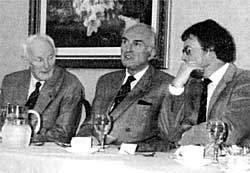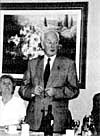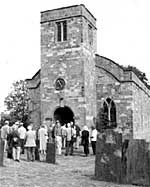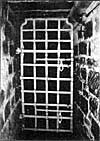Society events and lectures, Autumn 2003
 |
Mr Neville Hoskins, Mr Geoffrey Bond, Professor John Beckett. |
ANNUAL LUNCHEON
The Society's Annual Lunch was held this year at the Saracen's Head, in Southwell. 110 members and their guests attended. Professor John Beckett proposed the loyal toast, and Mr Alan Langton proposed a very generous toast to the Thoroton Society and its officers. Mr Neville Hoskins replied on behalf of the Society. Mr Geoffrey Bond then gave a fascinating account of his current position as one of the two Sheriffs of the City of London. Apart from having largely swapped Southwell for the Old Bailey during his year in office, he has to attend numerous functions (and eat even more meals!), but he travels everywhere in a chauffeur driven Rolls Royce and has a valet to remind him which of his many official outfits he is supposed to be wearing. Mr Bond, a life member of the Thoroton Society, fitted the Society's lunch into a busy schedule which will include a number of overseas visits on behalf of the City of London.
 |
Mr Neville Hoskins. |
After the meal Professor Beckett thanked the staff of the Saracen's Head, and expressed particular appreciation of the work of Mrs Barbara Cast, the Society's honorary secretary, in organising the occasion. He also informed members of the Society that next year's luncheon will be at Belvoir Castle.
REPORTS ON LECTURES AND EXCURSIONS
Saturday 6 September: Owthorpe and Colonel Hutchinson 's Garden. Leader: Dr Chris Salisbury
Our first stop was at St. Margaret's church (pictured left), which presents an unusual appearance, is in a field and is reached along a grass path. Chris Salisbury explained that the present building represents only the chancel of the original, and pointed out a date stone for 1629. The north wall is medieval, of liass stone, whilst the south is of better quality ironstone from the Belvoir ridge. The interior is Jacobean with an unusual roof structure and a painted wooden screen. It has been suggested that there is a lost crypt containing an upright female skeleton chained to the wall. The site of Col. Hutchinson's house is in a field immediately to the south of the church. It was demolished in the mid 19th century and nothing remains of it.
 |
Owthorpe church. |
The fishpond wood was reached along a public footpath which follows the line of a vista from the house towards Belvoir Castle. The wood was bought by Peter Birkin in 1999, and a small group of Friends of Fishpond Wood have since cleared 700 American poplar trees from the 61/2acre wood. The poplars had been planted by Bryant & May to make matchsticks. Our tour of the site explained the configuration of the ponds. We returned to the village hall for tea, kindly provided by Hazel Salisbury and Helen Hudson. The Owthorpe History and Archaeological Society provided interesting display panels explaining the village's history. We are grateful to Peter Birkin for giving permission to visit the wood, and to Chris Salisbury for organising a most interesting afternoon.
Howard Fisher
Saturday 11 October: Safe Sanctuaries - Fortification and Defence in Medieval Anglo-Scottish Border Churches. Leader: Dr Chris Brooke
Dr Brooke gave a well presented and superbly illustrated talk, taking us back to the turbulent days when violence and murderous raids were a regular occurrence in the Border region. The local church, as one of the few stone built structures in the area, became a welcome sanctuary, and was sometimes built or modified to provide protection and safety for a short period.
Dr Brooke explained the division of the region into the Scottish and English Marches, and showed the location of the best examples of these interesting buildings. Towers had very thick walls, slim high level windows, vaulted stone ceilings (to reduce fire risk), and narrow, exceptionally steep stairs (often with an unexpected change of angle halfway) leading to a secure room with fireplace and garderobe. Some tower arches were blocked off with the only access from the nave being via a small high level narrow door.
 |
Among the most striking examples were those in Burgh by Sands and Newton Arlosh, Cumbria. Burgh by Sands has a squat square west tower with lower walls of sandstone blocks. Over six feet thick, the walls at ground level are pierced by only two openings, that on the west face presenting to the exterior merely a five-inch wide slot nearly eight feet above ground level; on the north is a six-inch diameter gun loop, there is no external door to the tower or a tower arch. The only opening from the nave into the stone-vaulted ground floor chamber is protected by a substantial iron 'yet' (grille) complete with draw bar staples and bolts - see picture.
Guarding the Solway Firth is Newton Arlosh. The Bishop's licence to build the church specifically mentions 'hostile invasions by the Scots'. There is no external door into the tower. The south door into the nave is only 2' 7" wide; the thick wall between nave and tower at ground level was removed in the 19th century, but the high level door probably giving access to the upper floor via a ladder is still visible. Not only parish churches show these defensive features: Dr Brooke showed illustrations of abbeys and priories including Lanercost, Blanchland, Tynemouth with gatehouse and barbican, and Lindisfarne still showing parapets and cross-bow loops. He confirmed there were similar defended churches on the Welsh Marches, and some few examples elsewhere. The lecture was well received and members exploring the north border country will, I am sure, examine churches with a different eye in future.
Neville Hoskins
Tuesday 14 October: The Keith Train Memorial Lecture -Nottingham's Medieval Alabaster - Mr Francis Cheetham
This year's Keith Train Memorial Lecture was given by Francis Cheetham, a leading expert on English medieval alabaster. Some members may recall that he was for some time based at Nottingham's Castle Museum.
Alabaster is a very fine-grained variety of gypsum, usually snow-white or lightly coloured and where occurring massive, was suitable for carving. When polished alabaster has a marble-like surface. With suitable deposits at not far away Chellaston in Derbyshire from the late 1300s down to the Reformation, alabaster carving was a major activity in the English Midlands in an area centred on Nottingham.
Mr Cheetham had a comprehensive gallery of slides showing examples of altar-pieces, and carvings of the life of the Virgin, the life of Christ, and of Saints. Nottingham seems to have specialised in panels portraying the head of St. John the Baptist.
These high quality carvings were not just for the English market but, having wide appeal, were exported across Europe, particularly to France, and can be found in countries as diverse as Iceland and Croatia. Mr Cheetham has listed around 2,400 carvings, and he illustrated his lecture with some examples from the Victoria & Albert Museum, for which he has written the guide, and from the more modest collection at the Castle Museum.
Ken Brand
Saturday 8 November: The Nottinghamshire History Lecture - Continuity and Change in the Agricultural Labour Force in Nottinghamshire: the Strelley Estate from the 1850s to the First World War - Dr Nicola Verdon
Nicola Verdon was brought up in Norwell, so she knows the Nottinghamshire countryside well. In this lecture she used the outstanding set of labour records for the 200 acre home farm of the Edge family of Strelley covering the period 1857 to the 1930s to look in detail at who was working on the farm and how much they were being paid. Her trawl through the archive revealed the importance of family labour, with father and son combinations working the land from generation to generation. But the farm did not escape the cold winds of the agricultural depression. Despite the enforced loss of child labour as a result of the introduction of compulsory education, the most surprising finding related to women. Dr Verdon recently published a book on Rural women workers in nineteenth-century England (Boydell Press, 2002), and her particular interest in the work undertaken by women was clear in the second half of her lecture. In 1861 they were playing a significant role on the home farm, but in subsequent decades they were relegated to less important work than the men folk, they were paid 40% less for their efforts, and by the 1890s they had effectively disappeared from field work. The lecture will be published in the next Transactions.
John Beckett